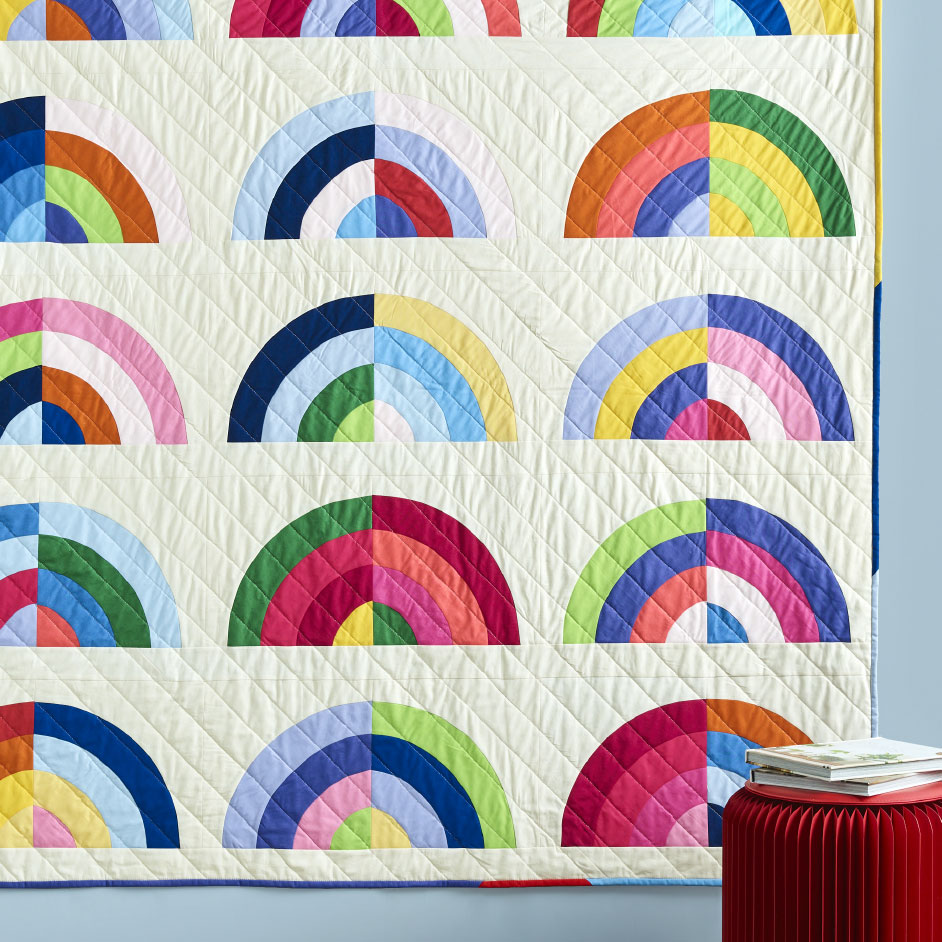 | ||
| Your browser is not supported. | ||
|
Please browse our site using any of the following options:
| ||
PRIMA RAINBOW QUILT 2

LEVEL: INTERMEDIATE
What you'll need:
- Approx 5m in total made up of a wide variety of different coloured fabrics (includes enough fabric to complete a rainbow binding). This quilt has approx 25 different colours.
- 5m background fabric
- 5 metres backing fabric
- 2m cotton/polyester batting
- Matching Gutterman 100% cotton thread
- Rotary cutter, mat and quilters ruler
- A square 12.5" quilters ruler will also be required.
- Quilting pins, tape measure
- Scissors, seam ripper
- Hand sewing needle
- Sewing machine foot and walking foot
- Marking pen
- Templastic or thick card to cut Rainbow Shapes for use as templates.
- Coloured pencils
All fabric should be 100% cotton, washed and pressed. ¼" seam allowance is used throughout unless indicated.
Please read all instructions carefully before commencing the quilt.
Finished Size:
60" x 60" (152cm x 152cm)
Half Rainbow represents one block, finished block size is 10" square, a total of 30 blocks is required.
Quilt is made up of 3 rows of 6 blocks wide by 5 blocks high with sashing underneath each row.
Terms
Rainbow Layer - refers to each layer of the rainbow
Arc - Top of the Rainbow Shape
Curve - Lower part of the Rainbow Shape
Stay Stitch - Line of sewing to prevent stretching
Template Preparation
Prior to commencing, print out the Rainbow Layer pattern page. Check the 1" line against your ruler to ensure template pages have printed at the correct size. There are 5 template pieces to be used for each block.
The background templates (Template 5a and Template 5b) will need to be joined where indicated on each piece, creating one template.
Cut templates on the inside of the line then place on to your templastic or cardboard and trace around. Carefully cut ensuring that each template piece keeps its shape and size.
Colour Layout
The rainbows are made up from a large selection of colours. If you wish, print the Grid page to assist with colour placement and use the coloured pencils to determine your rainbow layout. Alternatively, cut the different sized rainbow layers randomly from multiple fabric colours and lay them in a pleasing manner.
INSTRUCTIONS
Cutting
Depending on your skill level either trace around the templates using a marker and then cut with scissors OR use your rotary cutter.
Templates 1-4 (rainbow layers)
Rainbow layers are cut on the fold of the fabric (See Diagram 1). It's very important to cut all shapes as per the straight of grain guide on the template to ensure the 'stretch' of the fabric is available for the curve of the template. The placement line on each piece is the fold line so after cutting, open out the fabric piece and place a mark at the line which has been created by the fold of the fabric, top and bottom (See Diagram 2).
Template 5 (background)
The background shape is cut on a single layer of fabric.
Cut 5 strips at 11" wide. Follow the layout (See Diagram 4) for placement and cutting. Each 11" strip of fabric will yield 6 background pieces. Mark the placement line on each piece as per the template guide.
Sashing - Cut 10 x 2.5" strips from your background fabrics. Join two strips x 5 times and trim to 60.5" long.
Mix and match your rainbow layers. Once you are happy with your rainbow layout, it's time to start sewing.
Step 1 - Place layer 1 and layer 2 pieces right sides together match the centre placement line of the arc of layer 1 with the curve of layer 2. Place a pin at each end, holding the two shapes together. Ease the fabric of layer 2 around the edge of layer 1 pinning at multiple spacings. The more you pin, the easier it will be to create a nice seam as you sew creating a flowing curve (See Diagram 3).
Step 2 - Place layer 3 and layer 4 pieces right sides together in the same manner as the previous step and sew.
Step 3 - Gently press your joined pieces, ironing the seams outwards, towards the larger shape.
Step 4 - Place layer 3 on to layer 2 right sides together again and sew in the same manner as you have done with the layers in steps 1 and 2.
Step 5 - Again, gently press the joined pieces ironing the seams outwards.
Step 6 - Place background piece 5 and layer 4 together, ensuring that you match the pinning points. You will have ¼ inch of overhang of the background fabric (this will assist with the trimming in the following steps). Place a pin at the placement line joining with the fold line of layer 4. Pin around your shapes and sew.
Step 7 - Gently press the now completed block ensuring that all seams are ironed outwards towards the background fabric.
Step 8 - All blocks will need to be trimmed back to a 10.5" square. This will involve squaring the blocks to ensure the rainbow shapes and the squares meet correctly (Diagram 5). To reduce the opportunity for error I suggest using a marking pencil to rule along the cutting line on the two rainbow sides first.
Step 9 - Place your square ruler with the 2¾ line evenly against the sewing line where layer 1 and layer 2 meet. The joining lines of the other rainbow layers should be at a similar place to each other when the ruler is laying on the block. Once you are satisfied with the evenness of the square, rule the line along the two rainbow edges.
Step 10 - Turn the block in the opposite direction, ensuring that the 10.5" lines intersect at the corner of shape 1 and that the ruler lines follow the two lines. This will enable you to square up the two background sides of the block. Your block should now measure 10.5".
Step 11 - Once you are satisfied that your block is square and rainbow layers are of even measurements on each side, sew a line of stay stitching just under the ¼ inch line along the two sides of the rainbow. This will stop any stretching when you are joining the blocks.
Step 12 - Cut on the marking lines of the two rainbow sides of each block. Now that the block is cut it should measure 10.5".
Step 13 - Place the blocks into sets of two half rainbows. Match the seams of each layer. Pin and sew, creating a full rainbow.
Step 14 - Create 5 rows made up of 3 rainbows (6 blocks).
Step 15 - Join a sashing strip to the bottom of each of the 5 rows. Press seams to one side.
Step 16 - Join the bottom of each sashing piece to the top of each rainbow row until all 5 rows are joined together. Press seams to one side. Your quilt top is now complete.
Step 17 - Cut backing fabric in half so that you have 2 x 1.7 metre lengths and join together to create one large backing piece.
Step 18 - Lay the backing, batting and quilt top and baste together. Quilt as desired.
Step 19 - For a rainbow effect, cut a variety of 2.5" wide binding strips from your rainbow fabrics. Join on the bias to make one long strip, mixing the different fabrics. Press in half lengthwise and sew around the quilt, mitring the corners as you sew. Fold back and hand sew to the back of the quilt. Attach a label or sign and date your quilt. Stand back and admire your quilt.




